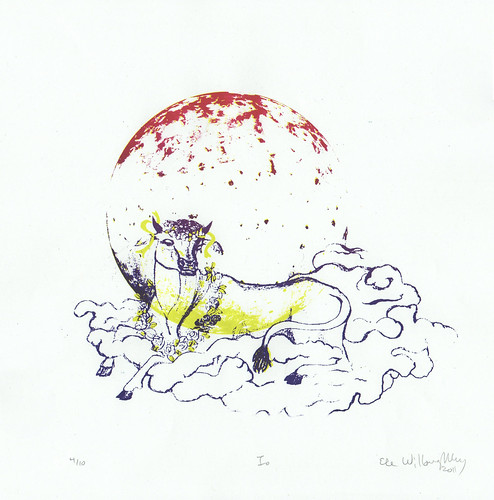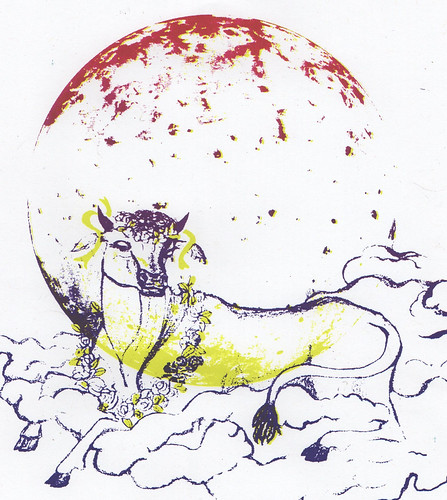Io, myth and moon

In this three colour (2 screen) screenprint, I combined Io, both the nympth (in cow-form) of Ancient Greek myth, and Io the large, volcanous moon of Jupiter. I'm interested in exploring the role of myth and imagination in science, and specifically here, how astronomical naming has been traditionally based on mythology. To make this screenprint, I combined my pencil drawings of cow/nymph Io and cloud with a NASA photograph of Io, which I manipulated. The screenprint is one of an edition of 10, printed in yellow (with a hint of lime), magenta and purple, on white paper, 28 cm (11 inches) square.
The story of Io is a funny one; she is one of many nymphs who caught the roving eye of notorious womanizer Zeus. As told by Ovid, in 'Metamorphoses', Io rejected Zeus' nighttime advances until the oracles lead her father to drive her into the fields. There, Zeus covered her with clouds to try and hide her from his justly jealous wife Hera, who nonetheless decuded there was something suspicious going on. Zeus then upped the ante and turned himself into a cloud and Io into a beautiful, white heifer. Hera, used to such nonsense, was not fooled and demanded the white heifer as a gift, which Zeus could not refuse. Needless to say, Hera kept this cow far from her unfaithful spouse. So, I made Io a lovely beribboned, heifer with garlands of flowers, resting on a fluffy (if lascivious) cloud.
The story goes on with more shenanigans, including Hera sending a gadfly to harass poor Io, which apparently has something (etymologically at least) to do with the oestrous cycle... but I didn't want to tell the revenge part of the tale, and no one wants to think about menses, though a relentless, vengeful, stinging gadfly does make some sense to me. Anyhow...

Io, the Jovian satellite - or moon, is the innermost of the four Galilean moons which Galileo first observed and identified (January 8, 1610 ) in orbit around Jupiter.* Galileo knew the importance of a good patron and he named them the 'Medician stars'. Io and her sister Jovian moons were important to the history of science. Their observation made it clear to Galileo that it was not possible that everything circled the earth if these moons circle Jupiter and thus, Copernicus must be right. We now know that this lovely moon is the most geologically active place in our solar system, with its more than 400 volcanoes fueled by tidal heating, as it is violently pulled in multiple directions by the strong gravity of Jupiter and the other moons. It has been beautifully photographed by a series of satelittes sent from Earth.
The Mad Scientists of Etsy challenge for this month is 'metamorphosis'. I thought I would make something related to science but with a less expected connection to the theme of 'metamorphosis'. Rather than natural, biological metamorphosis**, this print brings the mythological, metamorphosed Io (of Ovid's 'Metamorphoses') and the moon Io unexpectedly together.
*The IAU Gazetteer of Planetary Nomenclature points out that Simon Marius may even have observed Io days prior, but he neither published nor necessarily realized what he saw. Nonetheless, he named the Jovian moons. (He believed in Tycho Brahe's system, which was mid-way between helio- and geo-centric, with planets circling the sun, which in turn circles the Earth. At the risk of putting a footnote on my footnote, I'll point out that this in not as illogical as it sounds, because Tycho was an excellent experimentalist and couldn't justify a heliocentric model with his data... because he couldn't observe stellar parallax. So, he was wrong, not because he avoided new ideas, but because he was conscientious and the data for parallax was not acheivable with the technology of the time. Go team Tycho! Never underestimate an honest experimentalist.).
**Butterflies may be the new pirates, but I just don't like larvae.